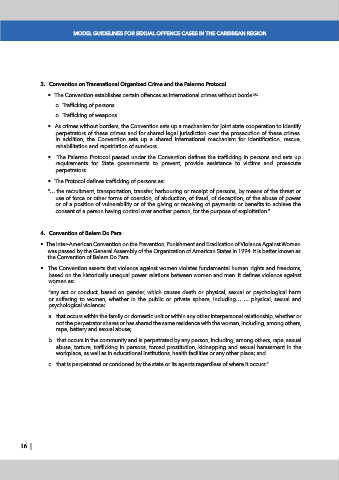Page 615 - Magistrates Conference 2019
P. 615
MODEL GUIDELINES FOR SEXUAL OFFENCE CASES IN THE CARIBBEAN REGION
3. Convention on Transnational Organized Crime and the Palermo Protocol
• The Convention establishes certain offences as international crimes without borders:
o Trafficking of persons
o Trafficking of weapons
• As crimes without borders, the Convention sets up a mechanism for joint state cooperation to identify
perpetrators of these crimes and for shared legal jurisdiction over the prosecution of these crimes.
In addition, the Convention sets up a shared international mechanism for identification, rescue,
rehabilitation and repatriation of survivors.
• The Palermo Protocol passed under the Convention defines the trafficking in persons and sets up
requirements for State governments to prevent, provide assistance to victims and prosecute
perpetrators.
• The Protocol defines trafficking of persons as:
“… the recruitment, transportation, transfer, harbouring or receipt of persons, by means of the threat or
use of force or other forms of coercion, of abduction, of fraud, of deception, of the abuse of power
or of a position of vulnerability or of the giving or receiving of payments or benefits to achieve the
consent of a person having control over another person, for the purpose of exploitation.”
4. Convention of Belem Do Para
• The Inter-American Convention on the Prevention, Punishment and Eradication of Violence Against Women
was passed by the General Assembly of the Organization of American States in 1994. It is better known as
the Convention of Belem Do Para.
• The Convention asserts that violence against women violates fundamental human rights and freedoms,
based on the historically unequal power relations between women and men. It defines violence against
women as:
“any act or conduct, based on gender, which causes death or physical, sexual or psychological harm
or suffering to women, whether in the public or private sphere, including… … physical, sexual and
psychological violence:
a. that occurs within the family or domestic unit or within any other interpersonal relationship, whether or
not the perpetrator shares or has shared the same residence with the woman, including, among others,
rape, battery and sexual abuse;
b. that occurs in the community and is perpetrated by any person, including, among others, rape, sexual
abuse, torture, trafficking in persons, forced prostitution, kidnapping and sexual harassment in the
workplace, as well as in educational institutions, health facilities or any other place; and
c. that is perpetrated or condoned by the state or its agents regardless of where it occurs.”
16 |

